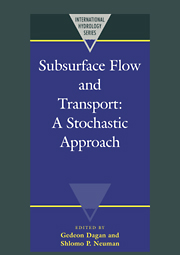Book contents
- Frontmatter
- Contents
- List of contributors
- Preface
- Acknowledgments
- I INTRODUCTION
- II SUBSURFACE CHARACTERIZATION AND PARAMETER ESTIMATION
- III FLOW MODELING AND AQUIFER MANAGEMENT
- 1 Groundwater flow in heterogeneous formations
- 2 Aspects of numerical methods in multiphase flows
- 3 Incorporating uncertainty into aquifer management models
- IV TRANSPORT IN HETEROGENEOUS AQUIFERS
- V FRACTURED ROCKS AND UNSATURATED SOILS
- VI A VIEW TO THE FUTURE
2 - Aspects of numerical methods in multiphase flows
Published online by Cambridge University Press: 04 December 2009
- Frontmatter
- Contents
- List of contributors
- Preface
- Acknowledgments
- I INTRODUCTION
- II SUBSURFACE CHARACTERIZATION AND PARAMETER ESTIMATION
- III FLOW MODELING AND AQUIFER MANAGEMENT
- 1 Groundwater flow in heterogeneous formations
- 2 Aspects of numerical methods in multiphase flows
- 3 Incorporating uncertainty into aquifer management models
- IV TRANSPORT IN HETEROGENEOUS AQUIFERS
- V FRACTURED ROCKS AND UNSATURATED SOILS
- VI A VIEW TO THE FUTURE
Summary
ABSTRACT The ability to simulate numerically single-phase and multiphase flow of fluids in porous media is extremely important in developing an understanding of the complex phenomena governing the flow. The flow is complicated by the presence of heterogeneities in the reservoir at many different length scales and by phenomena such as diffusion and dispersion. These effects must be effectively modeled by terms in coupled systems of nonlinear partial differential equations which form the basis of the simulator. The simulator must be able to model both single and multiphase flows and the transition regimes between the two in unsaturated flow applications. A discussion of some of the aspects of modeling unsaturated and multiphase flows in the presence of heterogeneities and channeling is presented along with directions for future work. Simulators are severely hampered by the lack of knowledge of reservoir properties, heterogeneities, and relevant length scales and important mechanisms like diffusion and dispersion. Simulations can be performed either deterministically, to predict the outcome of a single realization of reservoir and flow properties, or via stochastic techniques to incorporate uncertainties of flow directly. Due to the extreme difficulties in using stochastic differential equation models for nonlinear multiphase flows, we will concentrate on the potential of deterministic models. Recent developments have been made in homogenization, scaled averaging, and the use of the simulator as an experimental tool to develop methods to model the interrelations between localized and larger-scale media effects. Monte Carlo techniques using simulators with effective parameters can generate statistics for multiphase flow.
- Type
- Chapter
- Information
- Subsurface Flow and TransportA Stochastic Approach, pp. 92 - 100Publisher: Cambridge University PressPrint publication year: 1997
- 2
- Cited by



